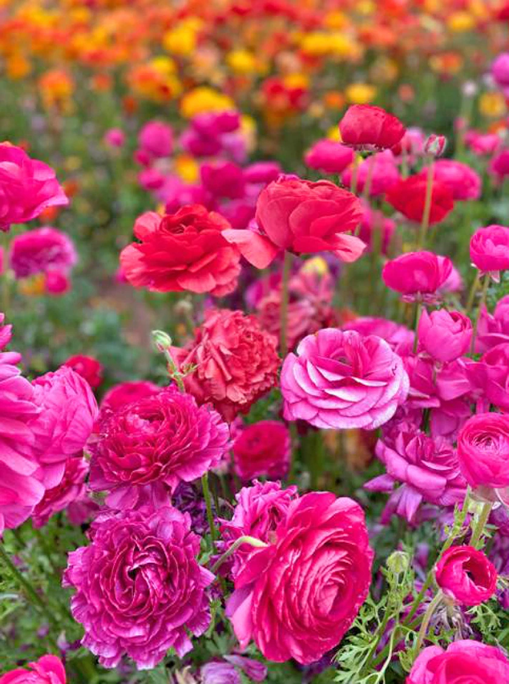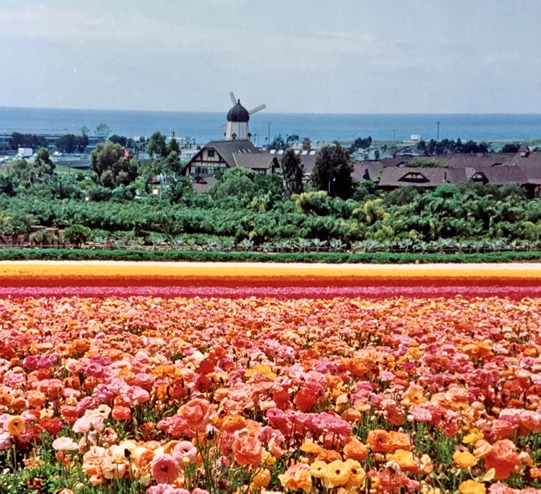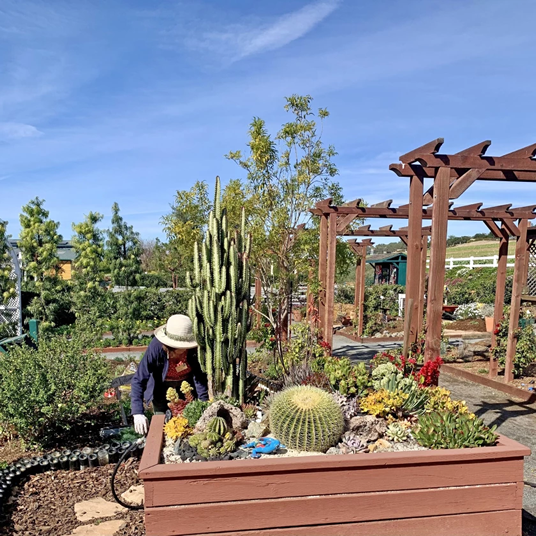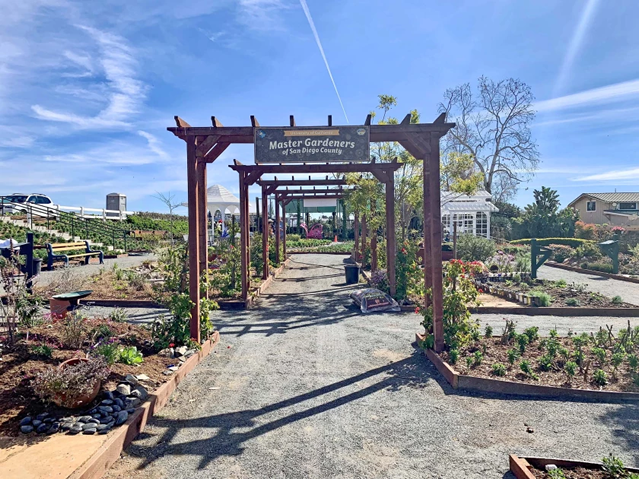Ranunculuses rooted in years of family farm history

‘Giant Tecolote Ranunculus Rose,’ in the foreground, is noted for its beautiful double blooms in a rich pink color.(Jodi Bay)
BY HELEN PURCELL MONTAG
(This article first appeared in the San Diego Union-Tribune on March 12, 2022)
Could it be ... spring is in the air? As we enjoy these longer daylight hours, have you noticed displays of budding leaves and early blooming flowers? Welcome to March, the month that marks the beginning of spring and the opening of one of San Diego County’s most recognizable floral landmarks: The Flower Fields at Carlsbad Ranch in Carlsbad. From March 1 through Mother’s Day, consider yourself invited to enjoy and embrace this year’s The Flower Fields 2022 theme, “Escape Into Color.”
Near the Pacific coastline at the base of a hillside, visitors gaze up in wonder at more than 50 acres of ranunculus plants in rows of vibrant pink, red, orange, white, salmon and yellow flowers. Ranunculus is a member of the buttercup family. Until the 1920s and 1930s, ranunculus flowers were single petal, in shades of red and yellow. Fast forward to today: The blooms are large and double-petaled; have tall, straight stems; and come in a variety of colors.
This floral landmark has a history that dates back a hundred years. Its story began with ranunculus seeds and the small discoveries that came from North San Diego County’s earliest floral cultivators, who worked the land, were patient and paid attention to developing optimum conditions for the seeds to germinate, flourish and grow.

One of these floral cultivators was Luther Gage. In 1922, Gage purchased a farm site near South Oceanside and began growing freesias, anemones and gladioluses. With seeds purchased from England, Gage also planted ranunculuses. As years went by, he developed varieties under the Giant Tecolote label, named after the nesting owls he found on his farm. Luther Gage Giant Tecolote Ranunculus Bulbs offered gardeners a marked improvement over the common French types available at that time, as his were double-flowered and came in different colors.
Along with Gage, the contributions of the Frazee family expanded and improved the knowledge of seeding, cultivating and irrigating ranunculus flowers. In the 1930s, Frank Frazee and his sons Earl and Edwin expanded the family’s farm business to include cultivating ranunculus flowers on several leased farmlands in North San Diego County, including today’s site owned by the Ecke family.
The beautiful colors and fullness of the ranunculus flowers we see at The Flower Fields can be attributed to the 60-plus years of Edwin Frazee’s careful selection of seeds gathered from flowers with unusual colors. When Edwin Frazee decided to retire, the Ecke family asked him to remain as a consultant to the new onsite growers, Mellano & Company of San Luis Rey.
There are now rows upon rows of ranunculus flowers in bloom. If you cannot decide which is your favorite color, look for the Picotee Mix blooms, characterized by their two-tone petals.
In addition to ranunculus flowers, The Flower Fields offer a variety of activities and sights to visitors. Look for the wagon rides, Artist Gardens and Aviaries, the Sweet Pea Maze, and the Cymbidium Orchid Greenhouse. There is even a blueberry stand to enjoy a U-Pick experience. To ensure that you’ll make the most of your visit, read through the “Frequently Asked Questions” page on The Flower Fields’ website.

A UCCE Master Gardener tends a plant bed at a the group’s demonstration garden at The Flower Fields in Carlsbad.(Helen Purcell Montag)
Get inspiration from the Demonstration Garden
Another highlight of any visit is the Demonstration Garden located at the bottom of the hill near the Armstrong Garden Center. This garden was established and is maintained by the Master Gardener Association of San Diego County. It features nine vignettes appropriate for small spaces and for those looking for inspiration on earth-friendly gardening practices. You will find native plants, proteas, meadow grasses and a pollinator bed, all highlighting sustainability goals of reducing energy use, conserving water and maintaining healthy soils.
The Master Gardeners also have created a small backyard orchard and vegetable bed that include whimsical miniature displays.
Perhaps your visit will inspire you to grow your own ranunculuses. The Giant Tecolote ranunculus is easy to grow, and the tuberous roots come in brilliant colors. Each root will produce many flowers with striking double-petaled blooms on tall, straight stems.
In the fall, plant the tuberous root in a sunny location in your garden where the soil is well-drained. Ideally, pick the area that will give your ranunculus plants the most sun in the afternoon. If your soil is dense, fine-tune and amend your flower bed with an organic compost, mixing it thoroughly into the soil.

Visitors are welcome to tour the Master Gardener Association’s Demonstration Garden, located near the Armstrong Garden Center. It offers nine vignettes that include native plants, a small orchard, meadow grasses, a vegetable bed and more.(Helen Purcell Montag)
Dig your soil to a depth of about 2 to 3 inches. Place each Giant Tecolote tuberous root with its “toes” pointing downward, spacing your plantings about 4 to 6 inches apart. Cover your tuberous roots with at least 1 ½ inches of soil.
After your tuberous roots have sprouted, water them once or twice a week. Once you notice that your plants are about 2 inches tall, fertilize them once a month with a 10-10-10 formula fertilizer.
Make several plantings, two weeks apart, to extend your spring blooming season. Staggering your plantings this way will ensure that you have blooms from March through May.
An often-quoted proverb that gardeners love says: “All the flowers of tomorrow are in the seeds of today.”
When it comes to ranunculus flowers, we thank Luther Gage and the Frazee, Ecke and Mellano families for their collaborative efforts, patience and attention to the ranunculus seeds from years ago that have gifted us the ranunculus flowers we enjoy today.
Purcell Montag is a UCCE Master Gardener who also enjoys history, travel, writing, genealogy and speaking Spanish.

